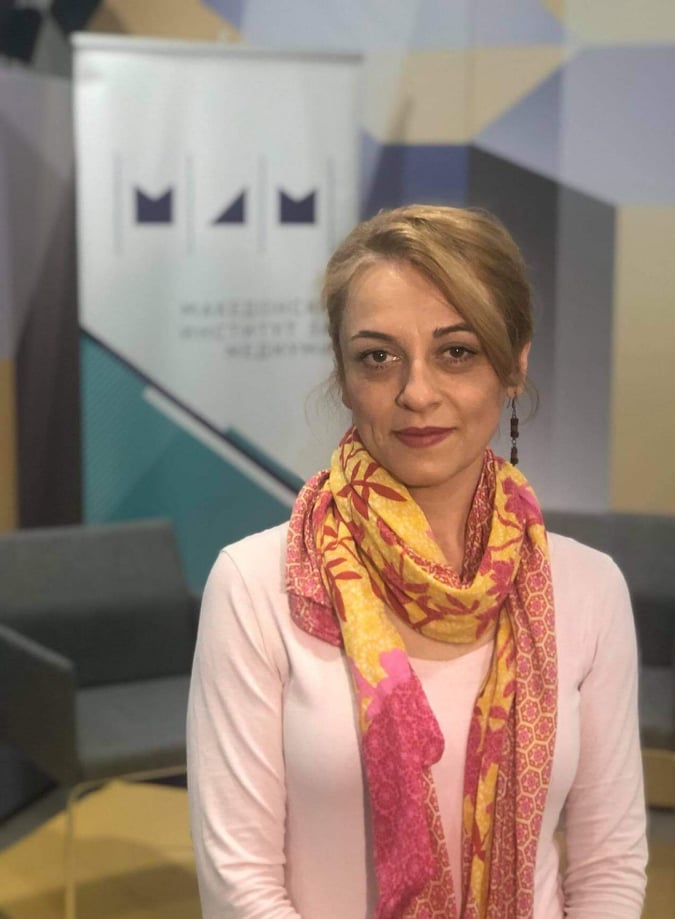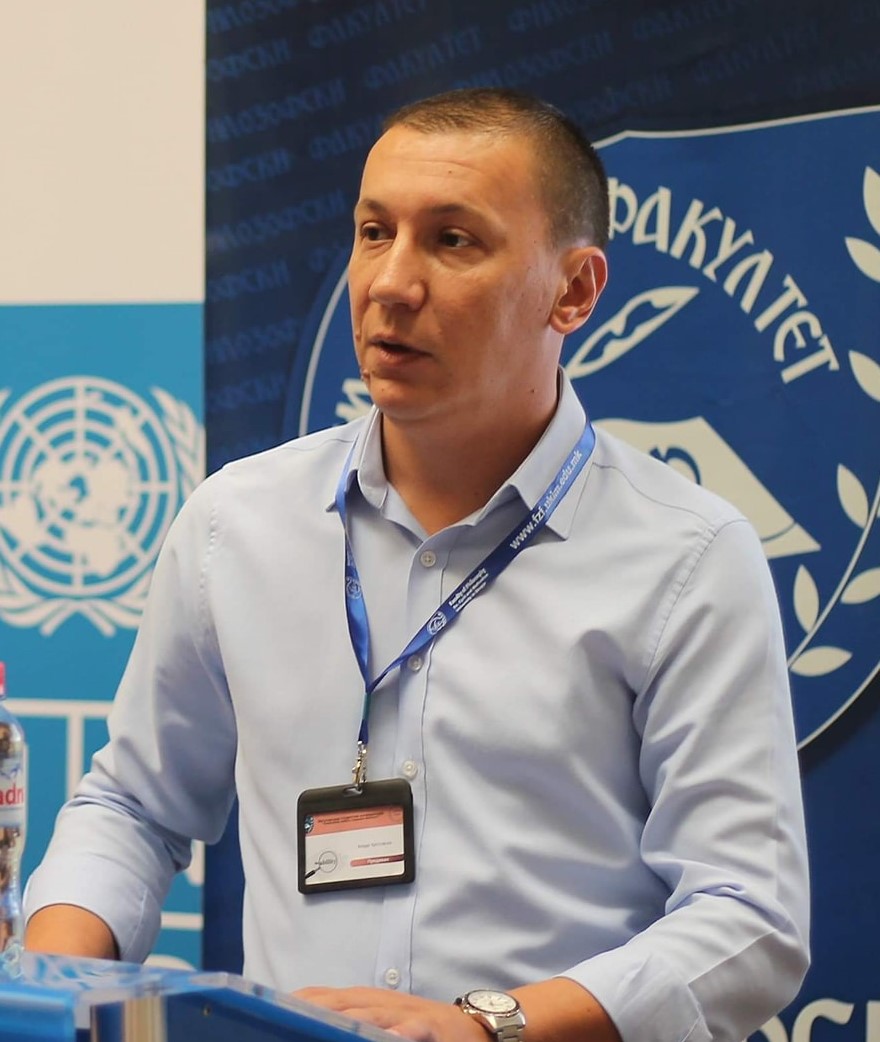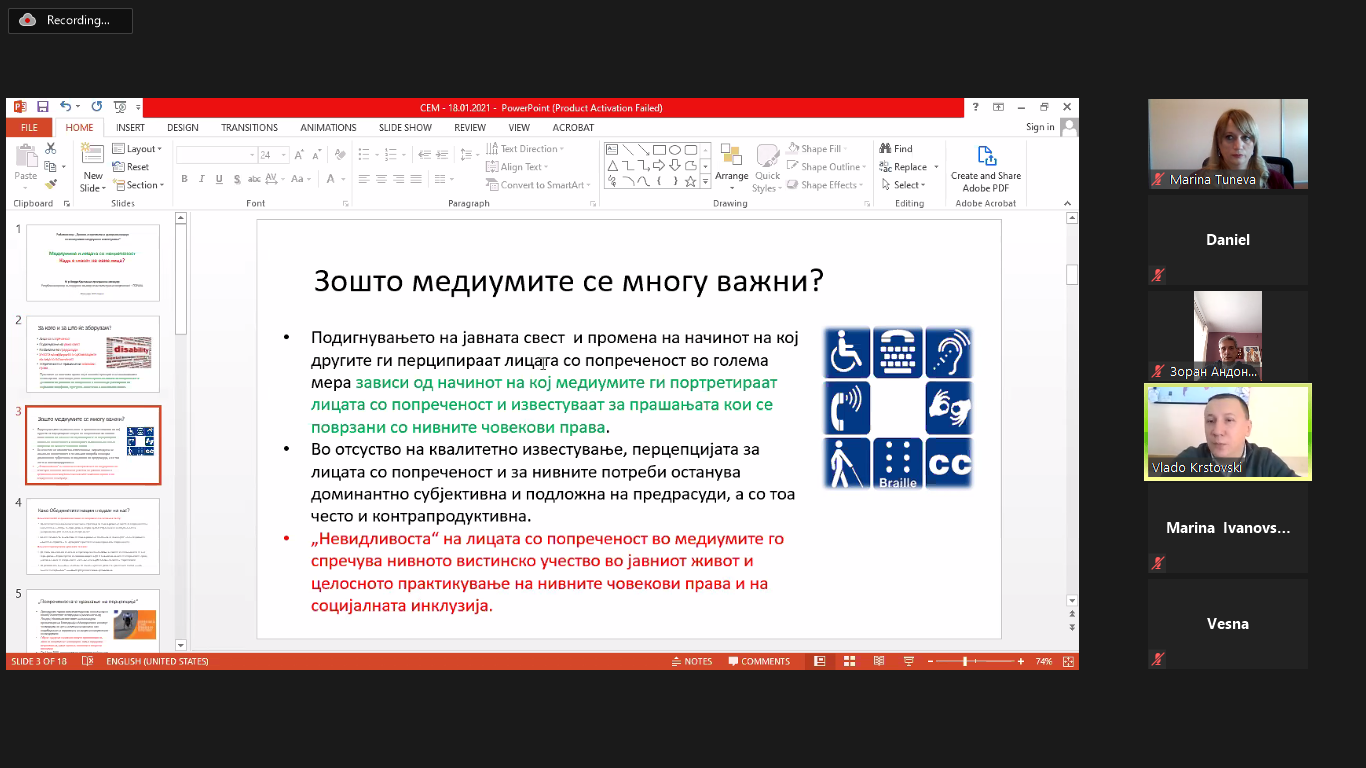CMEM Executive Director Marina Tuneva says that the focus of this project, supported by the Canadian Fund for Local Initiatives, as part of a series of events dedicated to combating hate speech and discrimination in the media, is directly related to the growing number of complaints received by the self-regulatory body on media coverage of various groups and individuals in the society. “We felt the need not only to address the questions about the available mechanisms and how and when to activate them in dealing with such phenomena, but also to consider how to affirmatively report on diversity in the media, i.e. to give genuine support to the concept of inclusive reporting”, emphasizes Tuneva.
CMEM, she says, has a tradition that will continue to reward professional journalism, which is especially concerned with inclusive reporting, because the understanding is that the media can help overcome this type of problem, by opening such issues to the public. They were further confirmed to be present during the ongoing covid pandemic. Undoubtedly, work should be done on the preparation of additional guidelines and standards on how to report on these social groups.
WHAT IS INCLUSIVE JOURNALISM??
Inclusive journalism is a set of value judgments (opinions, beliefs and emotions), editorial policies and reporting practices aimed  at ensuring the inclusion of diverse voices in the media sphere. Inclusive journalism should ensure the re-examination of the work and specific procedures carried out by journalists in order to offer a solution and answer to the inequalities that result from the improper functioning of social structures. The purpose of such journalism is, among other things, to provide reflective thinking about the processes in society, to include social, political and cultural pluralism, as well as to recognize and accept diversity, are the words of the Macedonian Institute of Media (MIM) researcher Vesna Nikodinovska. According to her, inclusive journalism is especially dependent on the journalists and the editorial boards where the selection of journalistic topics, practically decides who would be included or excluded from the content that creates the social image, and to what extent.
at ensuring the inclusion of diverse voices in the media sphere. Inclusive journalism should ensure the re-examination of the work and specific procedures carried out by journalists in order to offer a solution and answer to the inequalities that result from the improper functioning of social structures. The purpose of such journalism is, among other things, to provide reflective thinking about the processes in society, to include social, political and cultural pluralism, as well as to recognize and accept diversity, are the words of the Macedonian Institute of Media (MIM) researcher Vesna Nikodinovska. According to her, inclusive journalism is especially dependent on the journalists and the editorial boards where the selection of journalistic topics, practically decides who would be included or excluded from the content that creates the social image, and to what extent.
In the past period of the covid pandemic, MIM conducted several studies that showed that the increase in hate speech and discrimination in general, especially on social media has doubled, and at the expense of the inappropriate representation of marginalized groups, especially people with disabilities, the LGBTI population, the Roma community, i.e. smaller ethnic communities, and to a large extent children and women. “It is therefore necessary for journalists to include as many different voices from different groups and segments of society in their daily reporting as possible, as well as to use the precise terminology and designation, and to be especially careful in conveying xenophobic statements from public figures, in addition to the standard avoidance of stereotypes and generalizations. Media outlets, on the other hand, need to become as inclusive as possible and create both opposing and affirmative narratives for this category of people”, states Nikodinovska.
At the same time, institutions must be more actively engaged in combating disinformation and hate speech in the media. This should be especially true for the political parties that should be constantly asked to condemn such phenomena. In fact, the Council of Europe recommends infusing differences in media coverage.
WHERE IS THE VOICE OF PERSONS WITH DISABILITIES

For Vlado Krstevski from the Republic Center for Persons with Intellectual Disability “Poraka”[Message], there is no doubt that breaking down prejudices and raising public awareness about the rights of persons with intellectual disabilities is extremely important, and the media are very important actors in the whole process. It is extremely important that all their activities are accompanied by media reporting, and thus acknowledge the rights of persons with disabilities before the general public. Since, without that segment, some of the activities will not reach the decision makers relevant to this vulnerable category of citizens.
If there is no quality reporting, the perception of people with disabilities remains subjective and prejudiced, which is dominated by sympathy, pity, or mercy, which is counterproductive for them, as it leaves them “invisible” in the media, thus preventing their true participation in public life, as well as the full exercise of their human rights and social inclusion. “What can the media do?” They should first and foremost combat public prejudice that people with disabilities are incompetent and helpless. By using an affirmative approach, free from sensationalism, dramatization and compassion, media products should ensure that they are presented as people who can contribute in all areas of life, and thus promote a more inclusive and a more tolerant society. For example, some of the persons we interviewed said that their skills are oftentimes presented as superheroism”, underlined Krstevski.
He recommends improving the coverage of topics about these people in both quantity and quality. This means that greater journalistic engagement and greater initiative is needed to identify topics and cover them consistently – all the way up to the reactions of the institutions. The awareness of journalists and editors about the use of correct terminology regarding people with disabilities must be raised, in order to convince them to give as much room in their program contents in which they will present their capabilities and abilities and thus encourage the discourse of social normalization. But, that requires continuous training of journalists, workshops and a more frequent exploitation of such topics in the media. Naturally, just as is the case of ethnic stereotypes and discrimination, these topics should soon become part of the curricula of higher education institutions. Moreover, the establishment of stronger cooperation between the media and civil society organizations is needed so as to create an alliance to open and resolve such issues..
WHAT IS GENDER AND LGBTI DISCRIMINATION?
The panellist in the session of the workshop entitled “Gender Categories, Media Inequalities and Stereotypes towards the LGBTI Population” and researcher on gender in the media, Irena Cvetkovic from the Coalition “Margini” [Margins] also advocated for a synergy between the NGO sector and the media. Gender, she says, highlights the social and cultural distinction, as opposed to the biological sexual characteristics. The process of learning about gender begins at the youngest age and never ends, and gender socialization should be encouraged in the school environment, the media, other institutions and society as a whole, that should be considered as certain gender agents. Whenever the division of roles invokes biological factors, they (the roles) become the ground on which to gender stereotypes are reinforced.
The media is often dominated by the essential flaw of viewing reality through “pink shades”. Such a cover-up helps in keeping silent about sexism, prejudice, racism, chauvinism, exploitation and other forms of gender inequality. “Apparent equality is a category that we often encounter. It is a strategy of camouflaging inequalities. Thus, the presence of men and women in the media looks balanced. But, if you look at them in more detail in each section – you will notice that on the front pages or in the first or main sections – politics, economy, Macedonia and the world – the men are the ones that dominate, while from the middle to the end where the information is about the culture scene, entertainment, and leisure – the vast majority are women. The number is the same, but the essence is far from equal. This speaks volumes about the gender inequality in the media”, firmly states Cvetkovic.
She also called on the media to always have certain specific information and to follow the specific rules before opening gender sensitive topics and issues. For example, in the case of rape, the journalist should not be interested in the act itself, because it is extremely traumatic for the victim. There should be a familiarity with the global trends, i.e. the fact that 80 percent of such cases are reported years later, before asking the question “Why was this reported so late”.
As far as the LGBTI community is concerned, there are many techniques of discrimination. For example, homosexuality is presented as a mental illness that is the most common stereotype, even though half a century has passed since this attitude was prevalent. That is why journalists and the media have a greater responsibility to know these facts, in order to break the generally accepted stereotypes of many citizens. In that way, they will contribute to reducing the presence of hate speech towards this vulnerable category, which has been evident in the public lately. But, according to Irena Cvetkovic, when hate speech appears, it is usually in the form of defending the so-called “normal, healthy lifestyle”. Therefore, journalists and the media should show greater empathy and ethics towards these vulnerable categories of people, to know the human rights system, to use and quote sources of information in the right way, to avoid over exposing certain situations, to mind the language and style of writing and the be aware of the context.
JOURNALISTIC CHALLENGE FOR PROCESSING SUCH TOPICS
Petar Klincharski from “360 degrees” presented this from a journalistic point of view, i.e. the manner in which journalists view these issues, topics, problems and phenomena. He says that it has always been a challenge for him to work on topics related to vulnerable groups of citizens. He perceived it as a challenge because many editors and colleagues find the topic of vulnerable, marginalized groups easy at first glance. But, when the journalists start working on their topics, they realize that it is not like that at all.
“We are mostly focused on day-to-day politics, which are needed to fill the news or the newspaper and online media portals. But, when it comes to such topics, then the situation is a little more complex, especially if it is a television product in which the whole story should be captured. And, in particular because the way in which they are presented in the media has a key role in the public perception of a certain group and we as journalists must pay attention to the language in which we express ourselves”, said Klincharski.
What is crucial for him is that such a story must be free of sensationalism, especially if it is about the LGBTI community, transgender people, sex workers, and stateless people. Journalistic standards must be respected, and human dignity should not be forgotten. Journalists should look for people who have something to say about their lives, but their stories should be presented in a realistic manner. It is necessary, he says, to protect the identity of the interlocutor so that they are not exposed to severe discrimination and stigmatization from the environment. But above all, journalists need to gain their trust in order to get the right answers.
Of course, the role of the professional media in exposing stereotypes that are widely used on other platforms is extremely important. But, the problem that remains is that these issues and topics are often ignored. To the extent that it is visible that the communication with the ordinary citizen is lost, and it is more than necessary to restore it. Therefore, it is good to repeat the attempts to open such topics to the public as often as possible, in order to fight the dominant political narrative and to ensure that they claim the space in the public that righteously belongs to them.


